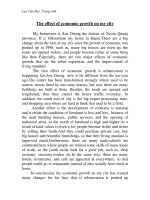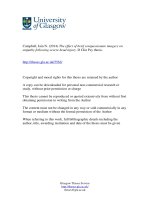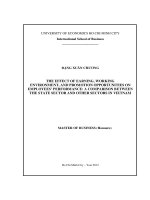effect of the market on construction of music manufactured b
Bạn đang xem bản rút gọn của tài liệu. Xem và tải ngay bản đầy đủ của tài liệu tại đây (38.75 KB, 4 trang )
Can Manufactured Bands ever be Classified as 'Good' Art?
The Effect of the Market on the Construction of MusicIntroduction
Manufactured bands now make up a major percentage of chart
music today, not least of them Take That, Boyzone, Bad Boys inc., East
17 and other all-boy pop bands. In this essay I would like to discuss how
the standard of art has been lowered by the capitalistic system of the
music industry, using a specific example - "Upside Down", which is
maybe the latest addition to this genre of music. By this genre of
music, I mean the all-boy bands which have been specifically
manufactured and targeted at the 'teenybopper' age class (and also the
gay market?).Personal Opinions To argue that this form of art is 'bad' art,
one must have a reference point - a set of values by which to judge. This
is almost always a personal opinion, and I would first of all like to explain
my personal opinion. I believe that 'good' art has something
to offer to the individual perceiver, be it painting, book, film, dance or
music. These are all different forms of art, but one thing binds them all
together - the fact that they are creations, created and crafted to the
personal specifications of the artist. This makes the product original.
Two values by which I judge music are creativity and originality. I
believe that good art provides 'food for thought' - that special something
which, after the tape has finished, after leaving the cinema or closing a
book, leaves an 'aftertaste' - something to think about, be it, 'how did
he/she play that' or, 'what was he/she trying to say with that piece,' the list
goes on. Basic Market Analysis For the purposes of this essay, I want to
split marketing into two general strategies. The first of these is where the
designers make a "product" to their own specifications and then look to
see where and how they will be able to sell it in the overall market. The
second strategy is the opposite of the first - the designers examine the
general market, target a certain area and tailor make a product to fit this
area exactly. The latter of these strategies is the one employed
when a band is going to be manufactured. The designers have studied
the market and worked out what they think they can sell a certain group
of consumers. Hirschman's 'three market segments' model
(see figure 1) can be used to explain which type of bands fall into which
category. The first segment is titled "Self-orientated Creativity." The
primary audience is the person who creates the piece and the primary
objective is that person's self-expression. This is art for the sake of art
and is sometimes called "selfish" art. The second segment is titled
"Peer-orientated creativity"; the primary audience are peers and industry,
the primary objective is recognition and acclaim. The third segment is
"Commercialised Creativity "and focuses on the general public with the
primary objective of money and profit. The people who create art for
the sake of art may not even approach a record label, as it is solely for
themselves. This approach is focused on the product, made their way,
not taking the commercial aspect into consideration. The people who fall
into the category of peer-orientated creativity do want to publish their
work but do not tailor their product to increase its marketing potential. An
example of this could be any band that has its own distinctive style, e.g.
Led Zeppelin, which when it was first published, definitely did not fall into
the category of pop music. Although they became a success and sold
millions of records, they did not compromise their music to do so. The
third group are one hundred percent commercially based. Any music
made by a band in this category is produced for a pre-specified area of
the market with the sole intention to make money. The product is tailored
according to what the mass audience wants, therefore any aspect of art is
compromised. Case Study - Upside Down Upside Down fit perfectly
into the third category in Hirschman's Three Market Segment Model. Put
together by two managers, they use the second of the general strategies I
have described above - first check the market to find an opening and then
tailor a product to fit it.In this case young girls aged roughly between 11
and 16 have been targeted. Having decided this, the next part of the
process is, based on what the managers think the consumers want (or
what they think they can tell them they want), to tailor make a product to
suit the market. In this situation, the question is, "What do girls aged
between 11 and 16 want to see when they go to a concert?" The answer
is, having experienced the reaction to Take That, Boyzone etc., that they
want young boys, in nice clothes, very good looking, very sexy looking,
who are going to look great on their bedroom walls when they get their
posters out of Smash Hits. So this is exactly what the managers design
and produce for them. The four boys that were eventually chosen
were picked from the applicants who had responded to this
advertisement: "Are you between 17 and 21 and good looking?
(We're only looking for the best!)" "Do you want to be in a
teenage all-boy band sensation?" "Do you want to follow performers like
Take that, East 17, Bad Boys inc. and Boyzone into the covers of Just 17
and Smash Hits?" "Do you want to be part of a band selling millions of
records? From the seven thousand applicants, a shortlist of
250 was drawn up from their photographs alone. These 250 were
auditioned in one day, each audition lasting about as long as it took for
the managers to discuss how the individuals looked. Once the four boys
had been trained by a voice trainer, the next step was to find material for
them to perform. Their first single-to-be was bought by the managers
from a firm selling previously unreleased songs. Several different
potential hits were played to the managers before they eventually picked
one to record in the studio.Upside Down's first studio sessions yielded a
different sound than their released single. It was described in the
documentary as having nearly a white soul-music quality, but the
managers were not happy with it at all. They proceeded to record the
single again with Stuart Levine - well known for his success in achieving a
more 'commercial' sound for music of this type, and his was the recording
that they finally used. Upside Down's first public performance took
place on the Smash Hits Tour, which, not surprisingly, was attended and
practically consisted only of girls aged between 10 and
15!EvaluationFigure 2 is a diagram which can be used to define the
difference between an object or work of art in the traditional sense (art for
the sake of music) and a cultural industry (art for the sake of making
money). The horizontal axis represents the range of products from works
of art which are aesthetically or artistically orientated to the works of art
which are market orientated. At the right hand side, the product is
determined by the market, and at the left hand side by the artist. The
vertical axis shows the range from prototypes, i.e. a unique piece of work,
through to cultural production on a mass scale.As I described above, in
the context of peer-orientated creativity, Led Zeppelin became a
big-selling band, but did not compromise their music to do so. On the
model, they would be represented by the 'Work of Art' (upper left
quadrant) which would then move down to the lower left quadrant where
the work is still orientated towards the artist, but reproduced because it
has become popular (i.e. moved down the vertical axis).Upside Down, on
the other hand, stay firmly in the lower right-hand quadrant of the
diagram, represented by 'Cultural Industries'. As their product is
tailor-made for the market, and always intended for mass reproduction, it
cannot be said that they have ever produced a prototype.This whole
attitude suggests and promotes the idea that money is more important
than art. This (business) venture is geared towards nothing else than
making money. In the documentary interview run by the BBC, The
managers stated that their aim was purely commercial, to quote one of
them, "Launching a band is launching a product. Identify your market,
package your product as nicely as possible, target your audience and sell
it to them." They also stated that only then would they have achieved
anything when "Ten thousand girls are screaming at the boys on stage,
some passing out from excitement and being taken away by the St John's
Ambulance Brigade.To create an image, the managers put the word out
that the four boys from England's next Mega-band would be in such and
such a place at such and such a time. They then turned up with the band
in the designated places and times to allow the 'fans' to kiss or be kissed
by, or get an autograph from the stars of the next biggest band in
England.The boys, however, are also in it only for the money, if not at first
then definitely now. They were given an allowance (not very much), and
told that the serious money would start rolling in as soon as the records
were starting to sell. In an interview with the boys, just after they had had
several thousand pounds worth of clothes bought for them, one said, "We
haven't really got used to having all these expensive clothes bought for us
yet, but hopefully we will."I find this approach to making music a very
manipulative one. The pre-targeted market of eleven to sixteen year olds
must be one of the easiest to manipulate. In this age, people are trying to
find themselves or make themselves into the type of people that the
media tell them they should be - if someone placed an advert in Just 17
or Smash Hits stating that every cool teenager now bought their fashion
clothes from Marks & Spencer's, this store would probably record a 300%
increase of sales in the Womenswear Department.On the other side of
the stage, however, the boys in the band are also being manipulated.
They are still, after over a year of being signed to the managers, receiving
the pitiful allowance assigned them by their managers. They have been
led to believe that they will be very rich, have given up university studies
and jobs to do so and yet have come no further financially. The records
are selling but until a certain number have been sold, they do not receive
any royalties, to allow the managers to recoup the quarter of a million
pounds they have invested. And when that sum is reached, will they still
be around or will the public have gone crazy about another four or five
sexy-looking boys who are essentially no different, just something
new?Apart from the dubious financial situation, the band have absolutely
no say in what they want their sound to be like. After the recording of the
single (which, incidentally the band had no hand in picking), one of the
boys was asked what he thought of the finished product; he answered, "I
liked the sound of the first recording better - it was less
commercial-sounding, but it depends if you're doing it for yourself or a
prospective audience."With his own recording technique, Stuart Levine
obviously managed to get a more 'poppy' and commercial sound which
the managers preferred. This ties in with one of Frans Birrer's definitions
of pop music, "Popular music is music that is not something else. This
ties in, in turn, to the 'McDonald's' Method - McDonalds actually deflavour
their burgers so that less people will dislike them. In exactly this way, and
for exactly the same reasons, Upside Down, or their managers at any
rate, have deflavoured their music - diluted it so that no one element is
too strong for people's musical tastebuds.What the band have also been
led to believe is that they possess a lot of talent, and have accordingly
acquired quite a high opinion of themselves and what they are doing: "I
think that masterminded bands are much better - it means that the best
talent, from a large area, is brought together and concentrated,"(!):The
performers themselves were obviously not chosen for any musical talent
or creativity, but on the strength of their looks. During the auditions, the
managers discussed the potential of the applicants. Comments ranged
from, "No, absolutely not - I don't like his style," ; "Pity about him, he's got
a good voice but look at his skin - we won't be able to do anything with his
acne," to "Looks great - bad voice, but nothing the studio can't fix," or
"Yeah, he's not bad, but I don't know about his hair. Maybe with some
dye and matching coloured contact lenses "If the band were so
talented, as they have come to think they are, then surely the managers
would not have needed to send them to a professional voice trainer,
when the only 'live' singing they have to do is in the studio? (All 'gigs' are
mimed) The voice trainer also did say,(rather dubiously I thought),
"We-ell, they have hope; they aren't the worst I've ever had."It seems that
the managers have achieved one of the earliest goals they set
themselves - "What we're basically looking for is four or five good-looking
boys who are eager to be moulded, well, guided, you know - given a
helping hand to do what we want them to do."I want to conclude by
saying that, based on my personal opinions of what 'good' art should be,
Upside Down are a good example of 'bad' art. The art in this venture lies
not in the music but in the management. The question is, is management
an art ?References:BBC Omnibus Documentary on the
Process of Manufacture of Upside Down, 1996LEDA Circuit on New
Opportunities for Employment Creation through the Cultural Sector,
1995Phil Saxe's Notes on Marketing Strategies




![gold et al - 2012 -the effect of engagement and review partner tenure and rotation on audit quality - evidence from germany [mapr]](https://media.store123doc.com/images/document/2015_01/06/medium_YF2viUqvRF.jpg)
![kwon et al - 2014 - the effect of mandatory audit firm rotation on audit quality and audit fees empirical - evidence from the korean audit market [mafr]](https://media.store123doc.com/images/document/2015_01/06/medium_har1420548188.jpg)
![ionescu - 2014 - the effect of mandatory partner rotation on audit quality [mapr]](https://media.store123doc.com/images/document/2015_01/06/medium_fam1420548198.jpg)
![black and kim - 2011 - the effect of board structure on firm value - a multiple identification strategies approach using korean data [kcgi]](https://media.store123doc.com/images/document/2015_01/06/medium_kxY7zGKWkx.jpg)

